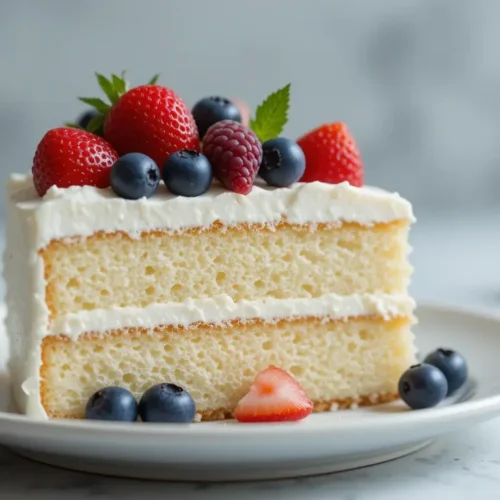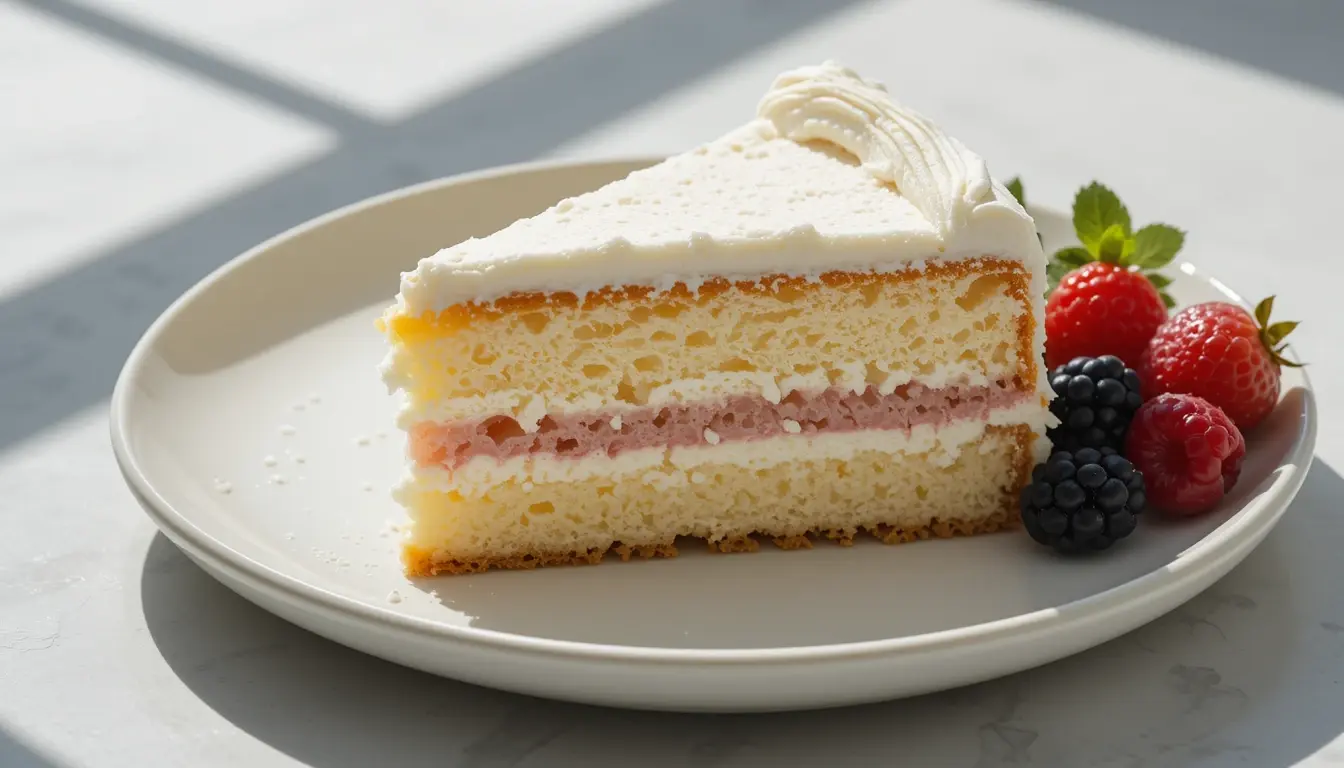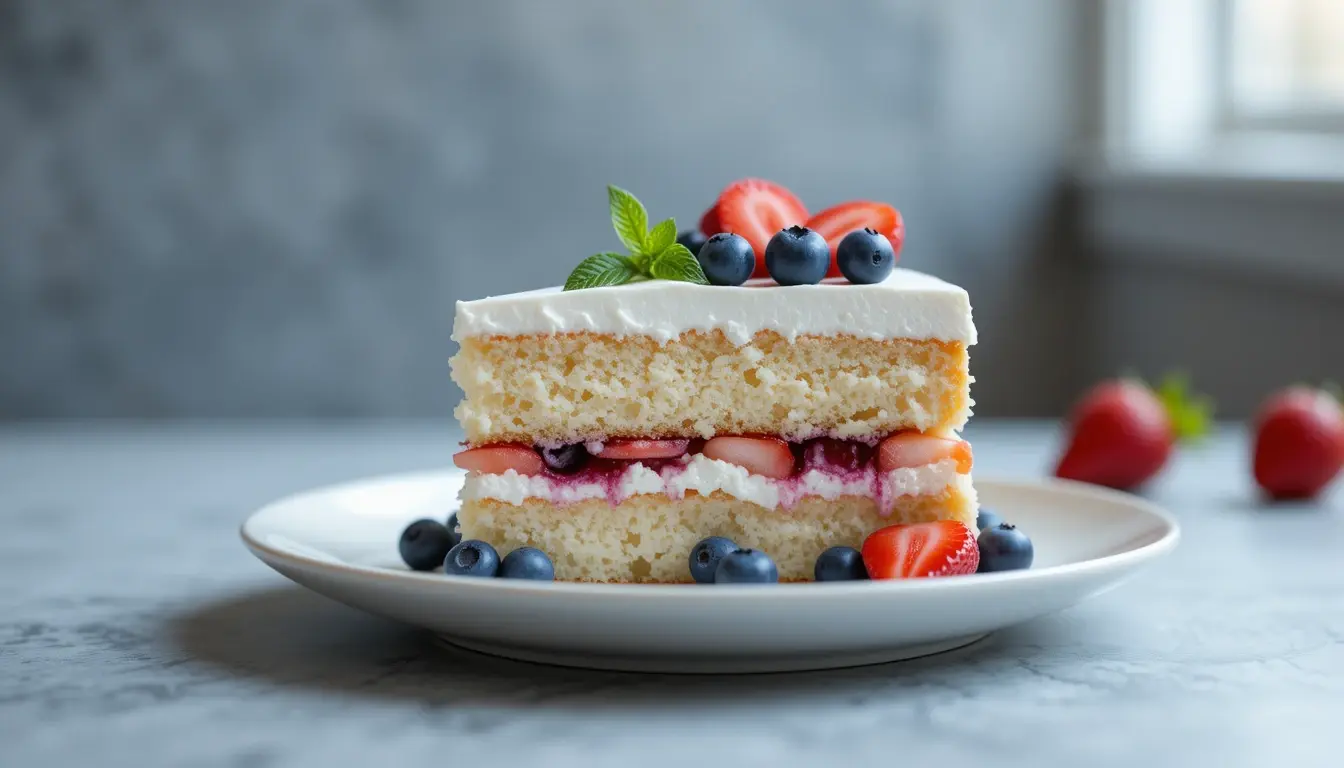You’ll learn the secret behind the sponge in rosemary’s bakery whipped cream cake, how to stabilize whipped cream naturally, and why this dessert is as timeless as it is delicious.
There’s something magical about a slice of rosemary’s bakery whipped cream cake. It’s the kind of dessert that doesn’t need elaborate decoration or complicated ingredients. This article walks you through the exact steps to recreate that beloved cake at home. With a sponge so tender and a whipped cream topping that holds beautifully, it’s no wonder this treat continues to charm generations.
In this guide, you’ll learn how to get the structure just right, whip the cream to cloud-like peaks, and build a cake that tastes like it came straight from Rosemary’s own kitchen.
Table of Contents
Rosemary’s Bakery Whipped Cream Cake
The Story & Intro
A Slice of Memory: My First Whipped Cream Cake
I was ten when I had my first bite of rosemary’s bakery whipped cream cake. It wasn’t from a supermarket or a fancy bakery. My mom brought it home in a plain white box from a little local spot in town. The cake inside felt like a secret soft layers and a whipped cream frosting so light you barely knew it was there.
Now, years later, baking in my kitchen outside Asheville, I find myself drawn to that same balance: not too sweet, always fresh, always welcoming. It reminds me of the kind of recipes I include at my supper clubs soulful, simple, and built on memory. This cake, like the ones from Rosemary’s bakery, relies on a good base and fresh ingredients, and it always leaves guests asking for seconds.
If you like cakes with personality, try pairing it with something like the pineapple coconut dream cake recipe for your next dessert table.
Why This Cake Still Captivates Today
The appeal of rosemary’s bakery whipped cream cake lies in its elegant simplicity. The sponge is fluffy yet firm enough to layer. The cream topping, subtly stabilized with cream cheese, gives structure without being heavy. It’s the kind of cake that satisfies without overwhelming.
Whether you serve it plain, with a dusting of powdered sugar, or topped with fruit, this whipped cream cake is an all-season favorite. It shares the same ease and balance you’ll find in desserts like the peanut butter cup dump cake low on effort, high on joy.
Building the Perfect Sponge for Rosemary’s Bakery Whipped Cream Cake
Egg-Based Sponge That’s Airy and Strong
The heart of rosemary’s bakery whipped cream cake is its sponge light yet capable of holding generous layers of cream without collapsing. Achieving that lift starts with room-temperature eggs. You’ll need six large ones, and they’re whipped for a solid 8 to 10 minutes. This isn’t just to make them fluffy. You’re building structure through air, which gives the sponge its delicate strength.
The mixture should triple in volume and take on a pale yellow tone. Once the eggs reach that cloud-like consistency, sugar and pure vanilla extract are added slowly. Keep that mixer running until everything’s smooth. It’s important not to rush this stage. That air you’re whipping in? It’s doing the work of baking powder without needing any.
This cake doesn’t rely on shortcuts. Its rise and texture come from attention to detail. That’s one reason rosemary’s bakery whipped cream cake is such a standout it feels light on the fork but stable enough to slice cleanly. The final result is a sponge that’s soft, fragrant, and ready for layers of rich whipped cream.
Mixing, Folding, and Baking Without Deflating
Once your egg base is ready, it’s time to sift the flour and salt together not once, but twice. This helps keep the flour light, so it blends easily into the airy eggs. You’ll fold the flour in gradually with a large spoon or spatula. It’s a quiet process. No beating, no vigorous stirring. Gentle folds are what keep all that volume intact.
Next comes the melted butter, cooled to prevent cooking the batter. Add it in carefully. Fold again just until combined. You don’t want streaks, but you also don’t want to overmix.
Pour the batter evenly into two parchment-lined 8-inch pans. Tap them gently on the counter to release any hidden air bubbles. Bake at 350°F for about 25 to 30 minutes, or until the tops spring back when touched. The aroma will fill your kitchen a hint of vanilla and butter, light and warm.
After baking, let the cakes rest in their pans for 10 minutes. Then invert them onto a cooling rack to avoid a soggy bottom. What you’ll have are two golden layers, perfectly flat, with just the right bounce. That structure is key for a whipped cream cake too soft and it sinks, too dense and it overshadows the cream.
This careful sponge process is part of what makes rosemary’s bakery whipped cream cake more than a recipe. It’s a technique worth mastering.

Rosemary’s Bakery Whipped Cream Cake
Equipment
- stand mixer or hand mixer
- mixing bowls
- Rubber spatula
- 8-inch round cake pans
- parchment paper
- Wire cooling rack
Ingredients
- 6 large eggs room temperature
- 1 cup granulated sugar
- 1 cup all-purpose flour sifted twice
- 2 tsp pure vanilla extract
- 1/4 tsp salt
- 3 tbsp unsalted butter melted and cooled
- 3 cups heavy whipping cream 36% fat
- 3/4 cup powdered sugar
- 2 tsp vanilla extract
- 4 oz cream cheese softened
Instructions
- Preheat oven to 350°F (175°C). Grease and line two 8-inch round cake pans with parchment.
- In a stand mixer, whip eggs on high speed for 8–10 minutes until tripled in volume and pale yellow.
- Gradually add sugar and vanilla extract, beating until incorporated.
- Sift flour and salt together. Gently fold into egg mixture in batches using a large spoon.
- Fold in melted butter just until combined, being careful not to deflate the batter.
- Divide batter between pans and bake for 25–30 minutes or until cakes spring back when touched.
- Cool cakes in pans for 10 minutes, then invert onto a rack to cool completely.
- Chill mixing bowl and beaters in freezer for 10 minutes. Beat cream cheese until smooth.
- Add heavy cream, powdered sugar, and vanilla to bowl. Beat until soft peaks form.
- Place one cake layer on a platter. Spread with whipped cream. Add second layer and cover top and sides with remaining cream.
- Refrigerate at least 1 hour before serving. Garnish with fresh berries or powdered sugar if desired.
Notes
Nutrition (Per Serving)
| Nutrient | Amount |
|---|---|
| Calories | 380 |
| Sugar | 21g |
| Sodium | 75mg |
| Fat | 28g |
| Saturated Fat | 17g |
| Unsaturated Fat | 9g |
| Trans Fat | 0g |
| Cholesterol | 165mg |
| Carbohydrates | 29g |
| Fiber | 0g |
| Protein | 6g |
The Dreamy Whipped Cream Frosting
Cream Cheese Stability Trick
One of the biggest secrets behind rosemary’s bakery whipped cream cake is its frosting. It’s light, smooth, and never weeps even after a full day in the fridge. The secret? A touch of cream cheese. You don’t taste it, but it gives the whipped cream body and stability, allowing it to hold its shape without turning dense.
Start by softening 4 ounces of cream cheese at room temperature. This ensures it blends smoothly. Beat it on medium speed until creamy. Then, in a bowl that’s been chilled for at least 10 minutes, add 3 cups of heavy whipping cream, ¾ cup powdered sugar, and 2 teaspoons of vanilla extract. Beat it all together until soft peaks form.
Soft peaks are the key here. You want the cream to stand with a slight curl on the tip. Go past that and you risk curdling or stiffness, which works against the soft elegance of rosemary’s bakery whipped cream cake. Once ready, you’ll notice how spreadable it is almost like mousse, but lighter.
And the flavor? Subtle vanilla with just enough richness from the cream cheese to feel indulgent without being overpowering.
Chilling Tools and Whipping to Soft Peaks
Temperature matters more than most realize when it comes to whipped cream. Everything should be cold your cream, your mixing bowl, even your beaters. That’s why placing them in the freezer for 10 minutes before whipping makes such a difference. Cold cream whips faster, stays firmer, and holds air longer.
When assembling rosemary’s bakery whipped cream cake, that firmness becomes crucial. The cream must support the cake layers and hold the shape on the sides without slipping or melting.
If you’re assembling in warm conditions, work quickly. You can even chill the assembled layers between steps. For an added twist, gently fold in citrus zest or a swirl of berry reduction. It won’t change the texture, but it will elevate the flavor profile for summer gatherings.
This whipped cream method is a foundational skill for any baker. Once you’ve made it, you’ll start imagining all the ways to use it on cupcakes, trifles, or even layered with fresh fruit in a glass.
Layering, Frosting, and Finishing Rosemary’s Bakery Whipped Cream Cake
Assembling the Cake with Structure
With the sponge fully cooled and whipped cream perfectly fluffed, it’s time to bring rosemary’s bakery whipped cream cake together. Start by placing one layer of the cake on your serving plate or cake stand. If the top is slightly domed, trim it flat with a serrated knife. This helps everything sit evenly and prevents sliding.
Spread a thick layer of whipped cream over the bottom layer using an offset spatula. Don’t press too hard just glide the cream into place, letting it naturally settle. Then place the second cake layer on top, gently aligning the edges.
From here, coat the top and sides with the remaining whipped cream. Work in slow, sweeping motions to avoid tearing the sponge. If you like clean edges, you can chill the cake for 15 minutes after applying a crumb coat, then apply a second layer of cream to finish it off.
This is when rosemary’s bakery whipped cream cake starts to resemble the memory: soft, snowy, and quietly beautiful.

Decorating Tips and Flavor Enhancers
This cake doesn’t demand decorations, but a few thoughtful touches can make it stand out. Try topping it with fresh berries, sliced strawberries, or a light dusting of powdered sugar for a classic finish. In cooler months, a sprinkle of shaved dark chocolate or toasted coconut adds visual interest and flavor depth.
Another beautiful option is to press thinly sliced fruit along the edges think kiwi or peaches for a burst of color. If you’re feeling nostalgic, finish with just one single maraschino cherry in the center, like they did at the original bakery.
Rosemary’s bakery whipped cream cake is best served chilled, but allow it to sit out for 10 minutes before slicing to soften the texture slightly. Leftovers keep well in the fridge for up to 3 days, though the whipped cream may start to lose some volume after 48 hours.
There’s something deeply satisfying about a cake that looks simple yet delivers so much in taste and texture. And with each slice, it carries not just flavor, but a feeling like it belongs in your family cookbook, passed on from hands that loved making it.

Conclusion: A Cake That Feels Like Home
There’s a reason rosemary’s bakery whipped cream cake still holds a place in hearts and kitchens. It’s gentle, graceful, and always leaves you wanting one more slice. From the airy sponge to the creamy, lightly sweet topping, it’s a dessert that respects the simplicity of good ingredients.
Whether you’re baking for guests or just honoring a memory, this cake gives you space to slow down and savor the process. And the best part? You don’t need any fancy skills just time, care, and the joy of sharing something made from scratch.
Keep it classic with this whipped cream beauty or add it to your dessert table alongside a bold, rich treat like the peanut butter cup dump cake for contrast. Either way, you’re building more than dessert. You’re building moments people will remember.
So whether you’re sharing it with friends or enjoying a quiet moment with coffee, rosemary’s bakery whipped cream cake makes every occasion just a little more special.
For more recipes follow me in Facebook
Frequently Asked Questions About Rosemary’s Bakery Whipped Cream Cake
How long will a whipped cream cake last?
A whipped cream cake like rosemary’s bakery whipped cream cake will stay fresh for about 2 to 3 days when stored properly in the refrigerator. Keep it in an airtight container or lightly covered with plastic wrap to avoid drying out or absorbing other odors. The whipped cream may begin to lose volume after 48 hours, but the flavor will remain delicious.
What is the name of the whipped cream cake?
The name most people remember is rosemary’s bakery whipped cream cake. Known for its ultra-light texture and clean vanilla flavor, it became popular thanks to its understated beauty and nostalgic flavor. This cake stands out for its balance delicate sponge and whipped cream that doesn’t overwhelm.
Why is my whipped cream cake sweating?
A whipped cream cake may “sweat” if it’s exposed to sudden temperature changes. Moisture from condensation collects on the surface, especially if a cold cake is placed in a warm environment. To avoid this, chill the cake gradually and allow it to rest at room temperature for about 10 minutes before serving.
How to apply whipped cream on a cake?
Apply whipped cream using an offset spatula for smooth coverage. Start from the center and gently spread outwards in thin, even layers. For rosemary’s bakery whipped cream cake, the key is soft peaks and chilled cream this allows it to glide without melting or tearing the sponge. Always chill the cake for at least an hour after frosting to help it set.


yummy